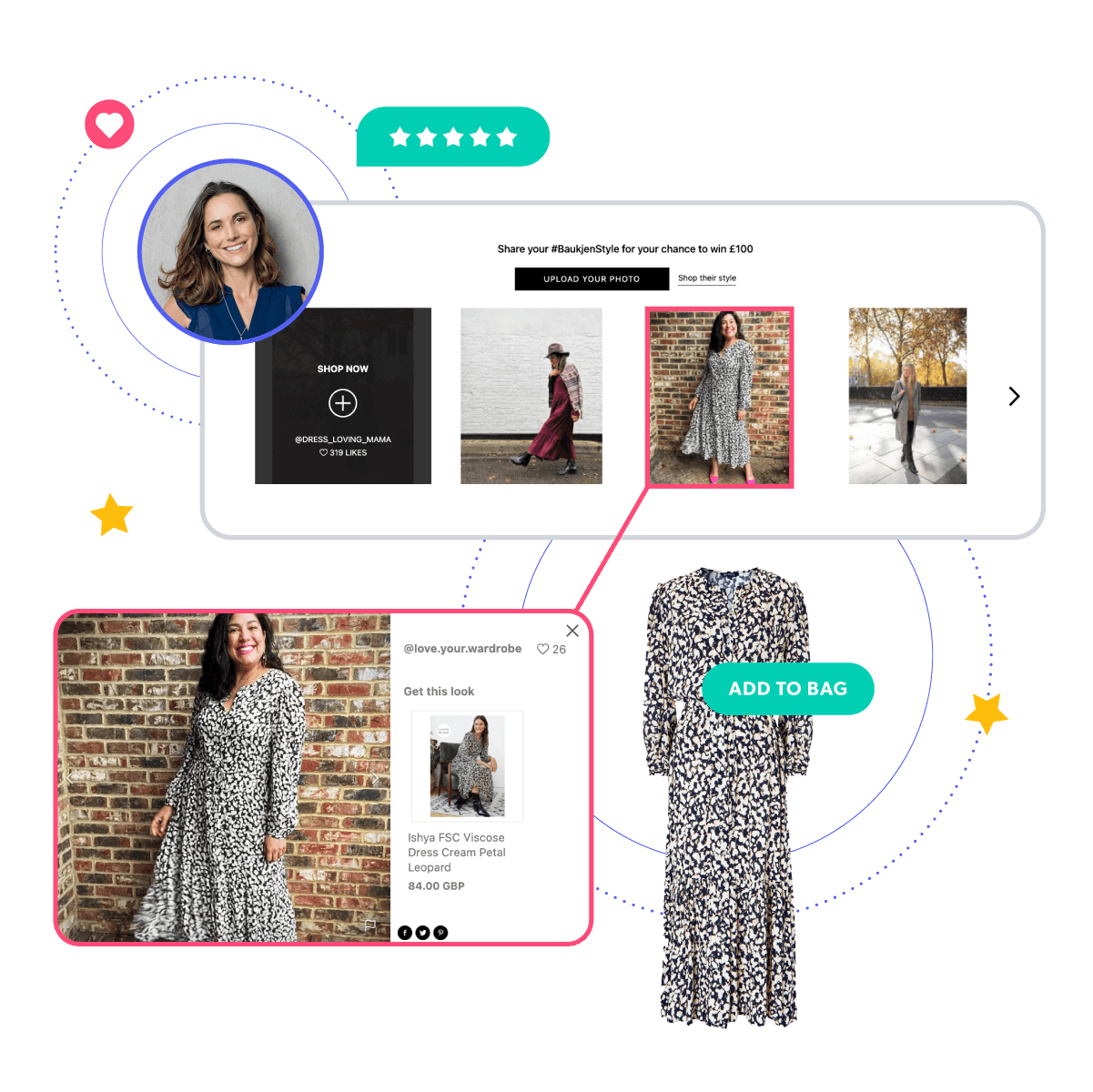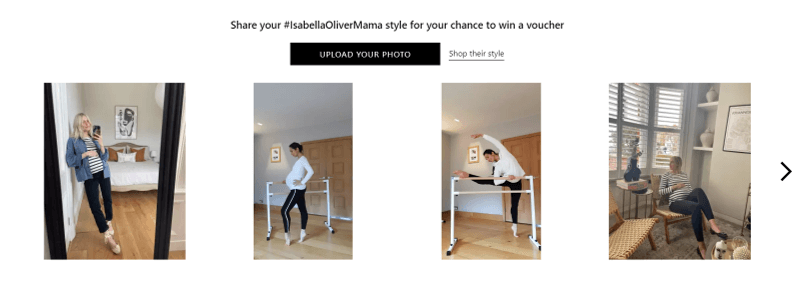
Taking Shape steigert Umsatz und Konversion in nur drei Monaten
Das Plus-Size-Modelabel nutzte alle Social-Commerce-Tools von Bazaarvoice, um Social- und E-Commerce für eine nahtlose kanalübergreifende Erfahrung zu integrieren.
Mehr dazu
Kleidung & Accessoires
Beide Marken produzieren umweltfreundliche und nachhaltige Kleidung. Und setzen zugleich auf die Veröffentlichung visueller Inhalten ihrer Kundinnen. Denn die Fotos und Videos zeigen, wie die Mode an anderen Kundinnen aussieht.

Auf einen Blick
Vertrauensaufbau, damit Kundinnen ihre Kaufentscheidung online leicht treffen können. Steigerung der Interaktion mit Social-Media-Inhalten
Zusammenarbeit mit Bazaarvoice und Erstellen visueller Inhalte. Präsentation der Inhalte in Fotogalerien auf den Unternehmenswebseiten und in E-Mail-Kampagnen
Isabella Oliver und Baukjen steigerten die Konversionsrate um über 120 Prozent. Zudem erhöhte sich der durchschnittliche Bestellwert um über 10 Prozent. Kunden verweilen dreimal so lange auf der Unternehmenswebseite, wenn sie mit Bazaarvoice Galleries interagieren
Steigerung der Konversionsrate
Isabella Oliver ist ein auf Umstandskleidung spezialisiertes Modeunternehmen mit Sitz in London. Baukjen de Swaan Arons gründete die Marke als sie selbst schwanger war. Denn sie wurde nicht fündig als sie nach stilvoller, ethisch und nachhaltig hergestellter Umstandskleidung suchte. Heute fertigt Isabella Oliver nachhaltige Umstandsmode und spricht nicht nur in Großbritannien, sondern weltweit einen loyalen Kundinnenstamm an. Die Frauen sind von der Umstandskleidung sogar so begeistert, dass sie die Mode-Items auch nach der Schwangerschaft gerne tragen. Aus diesem Kundenwunsch heraus wurde die Marke Baukjen geboren.
Der Vertrieb der Marken Isabella Oliver und Baukjen erfolgte seit der Gründung primär in Online-Shops. Seit kurzem wird die Kleidung aber auch in Einzelhandelsgeschäften in Großbritannien wie John Lewis & Partners verkauft.
Da der Vertrieb aber immer noch hauptsächlich online stattfindet, ist es extrem wichtig, dass Kundinnen die Kleidung vor dem Kauf virtuell „anprobieren“ können. Bislang wurden dafür professionelle Fotos verwendet. Und obwohl die makellos in Szene gesetzten Fotos perfekt waren, wünschten sich die Kundinnen noch mehr visuellen Input, um eine Kaufentscheidung zu treffen. Isabella Oliver und Baukjen erkannten, dass Kundinnen die Kleidung an unterschiedlichen Frauen sehen wollten. Denn dann würden sie eine bessere Vorstellung davon bekommen, wie die Kleidungsstücke an ihnen selbst aussehen.
„Optimal für uns ist es, wenn so viele Frauen wie möglich Fotos von unserer Mode teilen“, so Mattinson.
Am besten geeignet dafür, Kundinnen zu zeigen, wie die Kleidung an ihnen aussieht sind deren Fotos und Videos. Denn sie lenken Kundenerwartungen in die richtige Richtung. Und überzeugen die Kundinnen davon, das richtige Produkt zu kaufen. Die Inhalte von anderen Kunden sind unschätzbar wertvoll.
Und daher initiierte Mattinson einen Hashtag-Fotowettbewerb. Unter #baukjenstyle teilen Kundinnen seitdem Fotos und Videos. Fashionistas haben so die Möglichkeit, sich stilvoll zu präsentieren. Und Baukjen generiert eine Fülle an Kundenfotos. Beide Seiten profitieren also!

„Wir ermutigen unsere Kundinnen, ihre Looks auf Instagram und Facebook zu teilen“, erläutert Mattinson. „Einmal im Monat bestimmen wir eine Gewinnerin. Manchmal wählen wir zusätzlich ein paar Favoritinnen aus. Und teilen eine Auswahl der Kleidung, die sie tragen.“
Isabella Oliver und Baukjen nutzen Bazaarvoice Galleries, um Fotos ihrer Kundinnen aus sozialen Medien auf Produktseiten und Startseiten der Unternehmen und in E-Mail-Kampagnen zu präsentieren. Mit Bazaarvoice Galleries kann Mattinson ihre Lieblingsmotive schnell auswählen und teilen.
„Alle Fotos und Videos werden zentral bereitgestellt. Ich klicke mich einfach durch das Material und wähle die Fotos aus, die wir auf unseren Produktseiten und Startseiten zeigen wollen. Diese Fotogalerien verwenden wir auch für unser E-Mail-Marketing. Wir versenden drei- bis viermal die Woche E-Mails mit diesen Inhalten“, so Mattinson.
Die Marken entwickeln zusammen mit dem Bazaarvoice-Kundenserviceteam neue Strategien für die Bazaarvoice Galleries. Ziel ist einmal, noch mehr Inhalte zu generieren. Und zum anderen die Konversionsrate weiter zu erhöhen.
Isabella Oliver und Baukjen erhalten von ihren Kundinnen die Rückmeldung, dass die Fotos und Videos für ihre Kaufentscheidung sehr hilfreich sind.
„Wir bekommen tolles Feedback von unseren Kundinnen. Wie ‘Ich habe dieses Mode-Item an einer anderen Kundin gesehen und dann gekauft, weil ich eine ähnliche Körperform habe‘“, so Mattinson.
Sie haben auch A/B-Tests bei E-Mail-Kampagnen durchgeführt, wobei eine Gruppe E-Mails Galerien und eine andere E-Mails ohne Galerien erhalten haben. Das Ergebnis: Die E-Mail-Kampagnen mit Fotogalerien führen zu höheren Umsätzen.
Durch Analyse der Verweildauer der Kundinnen auf der Unternehmenswebseite und des durchschnittlichen Bestellwerts lassen sich die positiven Ergebnisse deutlich aufzeigen. So fallen Bestellungen höher aus, wenn sich die Kundinnen durch Fotogalerien auf der Startseite oder den Produktseiten inspirieren lassen. Mit Bazaarvoice lassen sich Konversionsraten um bis zu 150 Prozent erhöhen. Denn die Besucher auf der Webseite interagieren mit Fotos und Videos in den
Galerien.
Steigerung der Konversionsrate
Über das Unternehmen
Isabella Oliver und Baukjen produzieren umweltfreundliche und nachhaltige Kleidung für Frauen. Das Unternehmen hat seinen Sitz in London. Die Mode von Isabella Oliver und Baukjen erfüllt höchste Qualitätsstandards.

Wir bekommen tolles Feedback von unseren Kundinnen. Wie 'Ich habe dieses Mode-Item an einer anderen Kundin gesehen und dann gekauft, weil ich eine ähnliche Körperform habe‘.
Sophie Mattinson
Social Media Executive, Isabella Oliver und Baukjen

Das Plus-Size-Modelabel nutzte alle Social-Commerce-Tools von Bazaarvoice, um Social- und E-Commerce für eine nahtlose kanalübergreifende Erfahrung zu integrieren.
Mehr dazu

Brooks Running Australia (Brooks AU), ein führendes Unternehmen für Laufschuhe und Bekleidung, konnte durch das Sammeln und Syndizieren von Bewertungen seine Konversionsraten und seinen durchschnittlichen...
Mehr dazu

Durch die Sammlung und Syndizierung von mehr Bewertungen konnte der Einzelhändler für Sport- und Lifestyle-Schuhe seine Online-Präsenz, die Konversionsraten und seinen durchschnittlichen Bestellwert steigern.
Mehr dazu
Bazaarvoice unterstützt Sie dabei, Ihre Geschäftsziele zu erreichen und Ihr Unternehmen zum Erfolg zu führen.